The Mike Toole Show
Out of Order
by Michael Toole,
I was looking over a copy of Paradise Kiss-- specifically, Vertical's re-release of Ai Yazawa's singularly excellent josei manga series about a crew of aspiring artists, fashion designers, and models who grow up way too fast-- when it hit me. What about Neighborhood Stories? Neighborhood Stories came first, man. Like Paradise Kiss, it's a swank manga by Ai Yazawa, and like Paradise Kiss, it was so neat and different that it got made into a cartoon series. Sure, Paradise Kiss isn't exactly a sequel to Neighborhood Stories-- it's got appearances by the older story's star-crossed lovers, Mikako and Tsutomu, but it's more like a spinoff. Also, while Paradise Kiss is obviously josei, a tale geared towards older teen and twentysomething ladies, its predecessor is a delicious, candy-colored shoujo series for teens n' tweens. Still, it's kind of weird that you can get the later story in English, but not the earlier one, even after years of Paradise Kiss prominence, a hit run that includes a superior reprint by Vertical (Tokyopop did it first, just not quite as well), an animated series directed with swagger by Osamu Kobayashi, and even a live-action film version.
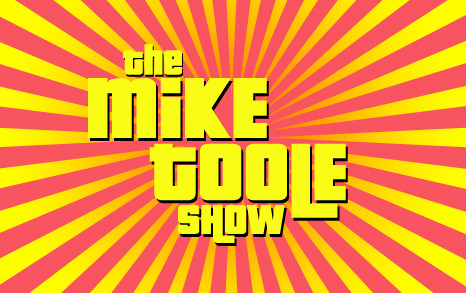
Paradise Kiss may be a spinoff, but Great Teacher Onizuka isn't, not really. Tohru Fujisawa's signature hit, which he's revisited in recent years, is the one that made his name here. Tokyopop made it part of their first wave of 100% Authentic titles, and it was a seemingly instant success-- the publisher boomed through the manga's 25-volume run, picked up Studio Pierrot's anime version, and even Media Blasters got into the act by releasing the live-action feature film. To Fujisawa's credit, GTO feels like a neat, stand-alone story-- sure, the titular Onizuka sees some old buddies through the story's run and sometimes references his wild days as a teen delinquent, but as a reader, it wasn't that easy to sense the outline of a larger story lurking behind GTO.
But, of course, there was one. Before GTO, Fujisawa penned Shonan Junai Gumi (“The Shonan Pure Love Gang”), a tale of a fearsome and violent pair of motorcycle punks who roam Shonan beach-- punks named Ryuji Danma and Eikichi Onizuka, the once and future Great Teacher. The art style in the two series is recognizably similar, but the tone is jarringly different-- while GTO is a positive tale about a reformed troublemaker who turns out to be an exceptional teacher, Shonan Junai Gumi starts off as a rough, sketchy gag series where two likeable high-school buffoons try to hide their glaring flaws in order to attract ladies. But when the tables turn, Onizuka and Danma spritz up their badass hairdos and get ready to fight! Fight! Fight! Later volumes introduce a surprisingly broad crew of buddies, love interests, rivals-turned-friends, and adversaries. Tokyopop, on the heels of GTO's success, started cranking this series out in double-length books with fascinatingly ugly covers, giving the tomes the headline GTO: The Early Years. But Shonan Junai Gumi never caught fire like GTO, and Tokyopop dropped it.
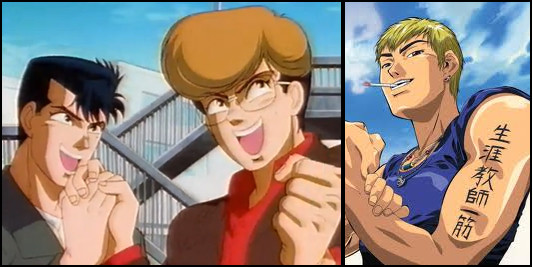
Thankfully, Shonan Junai Gumi's story doesn't end there-- Vertical grabbed up the final five volumes and released 'em. Of course, those first 10 books are still in limbo, and volumes 8 and 9 are the boogey-books, the ones that you pretty much can't get for less than $40 each. Hopefully Vertical gets around to these earlier volumes as well. But, just as was the case with the manga, the GTO anime came out before Shonan Junai Gumi-- and in fact, the latter still hasn't come out in English at all! Shonan Junai Gumi's 10-episode OVA adaptation, courtesy of J.C. Staff, is actually one of the fairly small number of 80s and 90s anime titles that never made the jump to DVD in Japan. Grotty-looking fansubs are floating around out there, but that just might be the best we get.
The thing is, while Shonan Junai Gumi is a fun read, it's really understandable why GTO made the great leap first, and Shonan barely made it at all-- it's all down to accessibility. While GTO is a relatable little comedy-drama, Shonan Junai Gumi is part of a very distinct subset of manga and anime about yankii and bosozouku and other stuff all about DELINQUENT TOUGH GUYS (and girls too!). Onizuki and Danma sport huge pompadours that are shorthand for “don't mess with me” in Japan but “way too much aqua net, dude” everywhere else. Before Shonan Junai Gumi, our examples of this little subgenre pretty much amounted to ADV's Bite Me! - Chameleon and AnimEigo's Bomber Bikers of Shonan, neither of which made any waves. Shonan Junai Gumi's ultimately a good read, but its visual shorthand make it a much tougher sell than its sequel.
When you sit down and think at some of the lousiest anime we ever got on DVD in North America, one title that's near the top of many of my peers' list is an OVA series called Knights of Ramune. Central Park Media farted this out at the turn of the millennium, and it's pretty easy to see why-- despite the fact that the show is filled with ugly, unpleasant characters and only flirts with coherent storytelling, it's nice and compact and absolutely stuffed with gratuitous nudity-- precisely the kind of forgettable OVA fare that companies like CPM and ADV Films targeted in that day and age. But what always gets me about Knights of Ramune is that, besides having a weak story, it just doesn't make any damn sense at all if you haven't seen its predecessors, starting with NG Knight Lamune & 40.
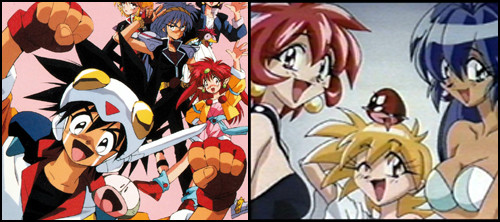
Yeah, that title's a real mouthful, isn't it? Despite its unwieldy title, the original Lamune, a shonen action/comedy series, is a fun watch, a tale of a good kid named Lamune who's summoned, via magical video game, to the kingdom of Hara-hara, where he must transform into the mighty Lamunes and battle evil. He's got a bunch of buddies also named after beverages, and faces off against the hilariously ineffectual Da Cider, one of those bad guys so entertaining that he ends up eventually joining the good guys. Lamune, a modest favorite in the age of VHS fansubs, would yield a pack of OVA sequels and a spinoff TV series, the even more awkwardly-titled VS Knight Lamune & 40 Fire, about the original hero's kid, which is where the Knights of Ramune OVA heroines, the shrine maidens Parfait and Cacao, come from. Without the context provided by this series, there's no way figure out the deal with them-- in Knights of Ramune, Parfait and Cacao, along with the whole conceit of a legendary hero named Lamune, are basically presented without comment or context. I'll admit that starting at the franchise's beginning, a 38-episode TV series, was probably a daunting prospect, but then again CPM did just go ahead and release plenty of mediocre TV fare like Himiko-Den and Maze. In any case, Knights of Ramune is pretty bad stuff, and you can chalk a bit of that up to its baffling lack of context.
VS Knight Lamune & 40 Fire proved to be a breakout hit for a young artist named Tsukasa Kotobuki, who had provided the show's character designs. Kotobuki wasn't entirely unknown at the time-- he'd drawn the characters for the video game Battle Arena Toshinden, which Sony pretty successfully positioned as a killer title for their PlayStation console-- but Lamune was his first anime hit. He went straight from Lamune to a franchise that, in my opinion, says “ANIME FROM THE 1990s!” louder than most of 'em: Saber Marionette J. Some columns back, I riffed on how little-remembered the whole Saber Marionette franchise seems to be, which prompted plenty of folks to speak up in its defense in the comments. I will admit that, at the time of its release, SMJ looked really fresh and exciting, and fans crowded in to check out its accessible mix of action and comedy and enjoy another buoyant performance by Megumi Hayashibara as the show's heroine, Lime.

But the thing is, Saber Marionette J wasn't first. Here, let me attempt to explain this: the whole Saber Marionette thing came from a radio drama (isn't it interesting how Japan still has stuff like radio dramas?). The OVA Saber Marionette R is based on that radio fare; it happens chronologically after Saber Marionette J, but it was released first. There's no real staff overlap, either-- different directors, and different character designer (in this case, Yukio Iwata). The only obvious continuity is the voice cast, which is the same-- and that makes sense only when you remember that this whole thing comes from radio dramas. Saber Marionette R was kind of an orphaned release-- Bandai Entertainment just barely eked it out on VHS, well after Saber Marionette J, an Anime Village launch title, and it vanished for several years. If not for Media Blasters rescuing it, I probably never would've seen it. But here's another case of this being understandable; Saber Marionette R isn't bad, exactly, but it bears little in common with its successor and doesn't bring a whole lot to the table, in terms of storytelling and animation. Unlike SMJ, which was pretty obviously intended to put the franchise on the map, SMR is a gift for fans of the radio program, kinda like the similarly radio-based Voogie's Angel. The only real surprise is that SMR came first-- until I did some research, I didn't know that myself!
There's a whole pile of popular anime franchises where later versions came out first thanks simply to market realities. I'm talking specifically about fare where there's a big, popular TV series in Japan, and then later there's high-gloss feature films-- but we end up getting the feature films here first. This practice goes right back to the early 1990s and fare like Dirty Pair: Project Eden, Castle of Cagliostro, and the Patlabor movies. This has never bothered me, simply because all of these films stand alone; you honestly don't need to know anything at all about the underlying Lupin the 3rd series to enjoy Cagliostro, and the same goes for Patlabor and Dirty Pair. In fairness, the depth of characters in Patlabor makes the movies more satisfying once you've seen the OVAs and TV series (coming soon on blu-ray from Sentai Filmworks, no less!), but Mamoru Oshii and company do a great job offering up stories that do not rely, in the slightest, on knowledge of previous material. A couple of years ago I published a controversial review of the Gundam 00 film on this here site; one of the problems I had with that movie is that it doesn't stand on its own well. These films do, and I think that's the biggest reason why we got 'em first.

Another franchise that came to our shores out of order but wasn't harmed by this is City Hunter. Like the above stuff, City Hunter doesn't rely too heavily on context and nuance-- once the director establishes that Ryo Saeba is a badass P.I. who haplessly chases women while his partner Kaori whacks him with a hammer, you're good to go. What intrigues me about City Hunter is the fact that we got the franchise pretty drastically out of order-- ADV Films started with the Goodbye My Sweetheart TV film, dubbing it City Hunter: The Motion Picture, before kicking out a trio of 1989-90 featurettes, and finally, the 1996 TV film The Secret Service. This release pattern smacks of some sort of complicated marketing plan whereby fans are sucked in by the modern animation of Goodbye, My Sweetheart and can then overlook the somewhat dated aesthetics of the older stuff; makes sense to me, like I said, simply because there's no setup needed to enjoy each film.
Of course, that leaves a critic like me wondering what happened with the original City Hunter goodness, the lengthy, 3-season TV series. ADV had a plan for that stuff, too-- it was big news when they nabbed what amounted to the entire franchise, but while they dubbed the films (with a great cast, despite some weird name changes) the TV series started off as subtitle-only boutique VHS releases, under the cheekily-named imprint ADV Fansubs. To their credit, ADV didn't rest on their laurels, and eventually released subtitled-only sets of City Hunter, City Hunter 2, and City Hunter '91. Only about half of the DVD sets are devilishly hard to find. But what of the final animated chapter of City Hunter, the 1999 Death of Ryo Saeba OVA? Time will tell.
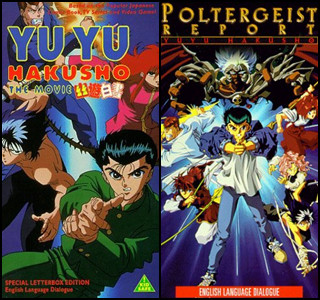
Some fare stands well on its own, but it really weirded me out when the Yu Yu Hakusho movies came out on video back in the late 90s. First of all, the two films were split across two publishers, so right off the bad we were gonna get two different voice casts. Also, the first YYH movie isn't really a feature film, just a 30-minute featurette meant to be packaged and run with other material in Japan. Finally, the whole YYH story is a bit too involved to just dump the viewer in, particularly in the feature-length second film. Upon its release, I found it hard to enjoy-- you really need to know a little about Yusuke and company to have fun with the movie, despite the fact that it closely follows the Shonen Jump movie formula, giving the sidekicks a task that ties them up, ensuring no pesky continuity or consequences, and introducing a special movie-only girl voiced by a hot new seiyuu. Years later Funimation would do Yu Yu Hakusho right, getting the entertaining supernatural fightin' series a TV airing-- and years after that, they'd eventually nab and re-dub that first Yu Yu Hakusho film. Puzzlingly, the second one remains in the void, without a much-needed redub and re-release.

Another decade-old franchise I brought up on the ANNCast last year is Di Gi Charat. Based on characters designed by Koge Donbo for the Gamers! chain of retail stores, the original Di Gi Charat is a hugely enjoyable sitcom, a series of energetic, funny 3-minute sketches about Dejiko, a girl who dreams of being an idol but is forced to work at Akihabara's Gamers! store to make ends meet. For a few years after Di Gi Charat's initial release in 1999, it was hot stuff-- there was a whole pile of sequels and related media, and multiple publishers ended up grabbing up different installments of Di Gi Charat anime.
Maybe this is the reason that we ultimately got Panyo Panyo Di Gi Charat, a 2002 offshoot of the 1999 original, first in North America, courtesy of one ADV Films. This does make a weird kind of sense, because Panyo Panyo is a prequel, a gag comedy that depicts a younger Dejiko and pals, long before they come to Akihabara and Gamers!. The original series, which for my money is still easily the best of the franchise, would eventually come out via Synch-Point, and a few years after that Bandai Entertainment dropped Di Gi Charat Nyo!, which came hilariously late for some reason. We're accustomed to anime releases taking a year or more after the initial broadcast in Japan, but it was a full three years after Bandai's licensing announcement in 2004 that they finally released the first DVD. That's a heck of a delay! A decade later, I'm still intrigued by how big Di Gi Charat was-- and by how quickly it seemed to vanish.
So, what does that leave us with? A few odds and ends, mainly. Thanks to some weird issues with licensor Enoki Films, Central Park Media released the Utena movie before completing the TV series, a fact which mattered not at all, since the Utena film is a glorious slice of stand-alone craziness. CPM's release of the Time Bokan OVA also isn't harmed too badly by the absence of the rest of the franchise, though it's amusing to listen to the dubbed version, which reveals that the crew adapting the material into English really had no idea who Hurricane Polymar and Gatchaman were. When we got a sequel to the much-loved 80s cosmic wrestling comedy Kinnikuman in 2002, 4Kids rushed out a silly adaptation-- one that, in my opinion, worked really well, retaining just enough details from the older show to amuse older fans, while not confusing the newer show's young target audience.
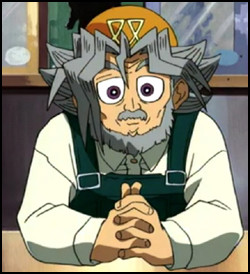
Speaking of 4Kids, I think the ultimate out-of-order anime release just might be Yu-Gi-Oh!. Every anime fan knows about Yu-Gi-Oh!, the thrilling adventures of Collectible Card Game Man as he shows the viewer, in excruciating detail, how to purchase and play Collectible Card Game. Most of us have seen at least an episode or two of the Yu-Gi-Oh! cartoon, a Studio Gallop production which debuted in 2000 and has returned to the airwaves repeatedly since then. But only Yu-Gi-Oh! true believers and trivia dorks like me have sought out and watched the original Yu-Gi-Oh!, a 1998 Toei TV series that uses the same manga as a jumping off point.
I had to toss this one in. The original Yu-Gi-Oh! doesn't tie up to its successor in storytelling terms, so missing out on it doesn't take anything away from foreign audiences like some of the other examples, but I find its obscurity fascinating. Yu-Gi-Oh! TV1, which CCG fans lovingly refer to as “season zero,” has never gotten a home video release of any kind-- even Shonan Junai Gumi got rental VHS cassettes, but not Yu-Gi-Oh!. It's weird to compare the two, as well-- O.G. Yugi is smaller and squeakier, and the entire cast of characters looks a little softer and less angular. Also, as I've pointed out before, Yu-Gi-Oh! TV1 has the amazing hypnotic power of Yugi's grandpa.
So how about you, readers? Has seeing a later piece of a franchise-- like a movie or TV sequel-- driven you to confusion, or just driven you to seek out the original? Are there shows where you saw a newer installment first, and then kinda wish you didn't go back and seek out the older stuff? Could you enjoy the Ghost Sweeper Mikami movie without the incredibly important context of the TV series? And finally, why the hell did Cartoon Network run Zoids: New Century before Chaotic Century, when it obviously came out afterwards in Japan? Sound off in the comments!
A final note: if you're in Seattle for SakuraCon 2013 next week, I'll be there-- you can see me presenting The Lighter Side of Gundam on Friday at 7:30pm, Dubs that Time Forgot on Saturday at 10pm, and a two-pack of Anime Cult Classics and Ghibli before Ghibli on Sunday. If you're there, come and say hi to me!
discuss this in the forum (37 posts) |
this article has been modified since it was originally posted; see change history